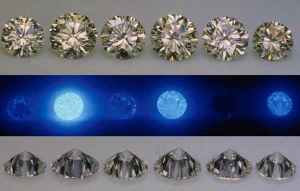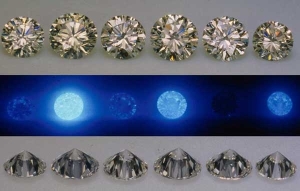- Joined
- Feb 26, 2003
- Messages
- 379
Re: Article: Over Grading of Blue Fluorescent Diamonds Revis
For those who may have gotten the impression that gemologist-appraiser Michael Cowing is a lone wolf crying "wolf", the following position article by the Accredited Gemologist Association may be of interest:
AGA Takes Position Urging Changes In Diamond
Color-Grading Procedures Following Research Showing
Grades For Fluorescent Diamonds May Mislead Consumers
In light of scientific data that shows there are insufficient UV emissions in most indoor lighting
environments—including those using daylight-type fluorescent lighting—to excite a color reaction
in fluorescent diamonds that is comparable to what is seen when the color is graded within a few
inches of a UV-emitting light source, the AGA contends that the use of UV emitting light to colorgrade
diamonds rather than lighting which is devoid of UV emissions results in grades for
fluorescent diamonds that distort the representation of quality and value and which do not
represent the color typically seen in today’s real world.
The AGA contends that in the case of fluorescent diamonds, scientific data shows that color grades based on the color seen when holding a diamond within a couple of inches of an unfiltered, UV-emitting light source is not the same color the diamond will appear when moved a short distance away from the light, and the farther away from the light, the greater the color difference. The color exhibited within a few inches of a UV-emitting light source is a color that will only be seen when held at such close distance, or when viewed outdoors, in natural daylight. Since many people today spend most of their time in indoor environments, and since the color grade indicated on most lab reports for fluorescent diamonds does not represent what people will see when viewed anywhere except in outdoor daylight environments, the AGA contends that the grade now shown on most lab reports for fluorescent diamonds misrepresents the color.
Furthermore, the AGA notes that the actual procedure currently used by major diamond grading
laboratories to color-grade diamonds is scientifically unsound. Current procedure requires that
“master stones” be non-fluorescing and the light source must be a daylight-type fluorescent light
that produces unfiltered fluorescent light containing UV emissions that will excite the fluorescent
reaction of any fluorescent diamond being graded. The color of any non-fluorescing master-stone
will not be impacted by UV emission coming from an unfiltered fluorescent bulb, while the color of
any fluorescent diamond is impacted by the UV emission. To make a fair comparison, the colorgrading
of any fluorescent diamond against a non-fluorescing master-stone would require making
the comparison when the fluorescent diamond is in its “steady state” rather than its “excited state”
(the “excited” state is when its fluorescent reaction is triggered by the UV emission from the
unfiltered fluorescent bulb); a fluorescent diamond’s “steady” state would be its “inherent body
color” and not the color it appears only when it is fluorescing.
The AGA contends that to compare a non-fluorescing “master stone” against a diamond in which the color has been temporarily altered
as a result of the excitation of its fluorescence triggered by the mandated light source is contrary to good scientific procedure. To grade in this way provides an inappropriate comparison resulting in a grade that does not represent the color the diamond will show in its “steady” state, which is the state most frequently observed except when viewed in outdoor daylight.
Furthermore, scientific data confirms that the color shown by a fluorescent diamond in outdoor
daylight is not a constant color because UV emissions in outdoor daylight vary dramatically
depending upon many factors (see Appendices D-F). Therefore the color grade now assigned by
laboratories, using current procedures, does not even represent a constant color that will be seen in
outdoor daylight. Therefore, the AGA contends that the best way to ensure consistent color-grading
and to avoid dramatic color inconsistencies due to the variables found in UV emissions, both
indoors and outdoors, is to use lighting devoid of UV so that the color grade reflects its most
consistent color: the stone’s “steady” color (its inherent body color).
The AGA further contends that while the color of any diamond, fluorescent or non-fluorescent, can
be affected by the wavelengths of light in which it is seen, only fluorescent diamonds may exhibit a
color significantly different from its inherent body color, depending upon the strength of its
fluorescence, and the particular wavelengths of light in which it is viewed. Therefore, the AGA
contends that diamond grading reports would better communicate, and more honestly represent the
unique character of a fluorescent diamond, by providing two color grades that would show the
range of color that may be seen in the particular stone—1) the stone’s “steady” color (its” inherent
body color”) seen in lighting devoid of UV emissions, and 2) the “excited” color seen when graded
with UV-emitting lighting for which a precise standard has been defined.
Finally, the AGA contends that to continue to grade fluorescent diamonds as they are currently
graded results in a situation whereby the interests of the buyer as it relates to value are not being
honestly served. In the case of fluorescent diamonds, the color grades now shown on diamond
grading reports issued by labs using a UV-emitting light source indicate the color the stone appears
in its “excited” state and can be several grades higher than the stone’s inherent body color (the
actual color that will be seen in any light except outdoor daylight, or when held deliberately close to
a UV-emitting light source). The AGA contends that such diamonds are priced higher (and in some
cases, much higher) than prices would be if grades reflected a stone’s inherent body color—the
color normally seen—and that even when “discounts for fluorescence” are factored into the
pricing, prices may still be significantly inflated.

For those who may have gotten the impression that gemologist-appraiser Michael Cowing is a lone wolf crying "wolf", the following position article by the Accredited Gemologist Association may be of interest:
AGA Takes Position Urging Changes In Diamond
Color-Grading Procedures Following Research Showing
Grades For Fluorescent Diamonds May Mislead Consumers
In light of scientific data that shows there are insufficient UV emissions in most indoor lighting
environments—including those using daylight-type fluorescent lighting—to excite a color reaction
in fluorescent diamonds that is comparable to what is seen when the color is graded within a few
inches of a UV-emitting light source, the AGA contends that the use of UV emitting light to colorgrade
diamonds rather than lighting which is devoid of UV emissions results in grades for
fluorescent diamonds that distort the representation of quality and value and which do not
represent the color typically seen in today’s real world.
The AGA contends that in the case of fluorescent diamonds, scientific data shows that color grades based on the color seen when holding a diamond within a couple of inches of an unfiltered, UV-emitting light source is not the same color the diamond will appear when moved a short distance away from the light, and the farther away from the light, the greater the color difference. The color exhibited within a few inches of a UV-emitting light source is a color that will only be seen when held at such close distance, or when viewed outdoors, in natural daylight. Since many people today spend most of their time in indoor environments, and since the color grade indicated on most lab reports for fluorescent diamonds does not represent what people will see when viewed anywhere except in outdoor daylight environments, the AGA contends that the grade now shown on most lab reports for fluorescent diamonds misrepresents the color.
Furthermore, the AGA notes that the actual procedure currently used by major diamond grading
laboratories to color-grade diamonds is scientifically unsound. Current procedure requires that
“master stones” be non-fluorescing and the light source must be a daylight-type fluorescent light
that produces unfiltered fluorescent light containing UV emissions that will excite the fluorescent
reaction of any fluorescent diamond being graded. The color of any non-fluorescing master-stone
will not be impacted by UV emission coming from an unfiltered fluorescent bulb, while the color of
any fluorescent diamond is impacted by the UV emission. To make a fair comparison, the colorgrading
of any fluorescent diamond against a non-fluorescing master-stone would require making
the comparison when the fluorescent diamond is in its “steady state” rather than its “excited state”
(the “excited” state is when its fluorescent reaction is triggered by the UV emission from the
unfiltered fluorescent bulb); a fluorescent diamond’s “steady” state would be its “inherent body
color” and not the color it appears only when it is fluorescing.
The AGA contends that to compare a non-fluorescing “master stone” against a diamond in which the color has been temporarily altered
as a result of the excitation of its fluorescence triggered by the mandated light source is contrary to good scientific procedure. To grade in this way provides an inappropriate comparison resulting in a grade that does not represent the color the diamond will show in its “steady” state, which is the state most frequently observed except when viewed in outdoor daylight.
Furthermore, scientific data confirms that the color shown by a fluorescent diamond in outdoor
daylight is not a constant color because UV emissions in outdoor daylight vary dramatically
depending upon many factors (see Appendices D-F). Therefore the color grade now assigned by
laboratories, using current procedures, does not even represent a constant color that will be seen in
outdoor daylight. Therefore, the AGA contends that the best way to ensure consistent color-grading
and to avoid dramatic color inconsistencies due to the variables found in UV emissions, both
indoors and outdoors, is to use lighting devoid of UV so that the color grade reflects its most
consistent color: the stone’s “steady” color (its inherent body color).
The AGA further contends that while the color of any diamond, fluorescent or non-fluorescent, can
be affected by the wavelengths of light in which it is seen, only fluorescent diamonds may exhibit a
color significantly different from its inherent body color, depending upon the strength of its
fluorescence, and the particular wavelengths of light in which it is viewed. Therefore, the AGA
contends that diamond grading reports would better communicate, and more honestly represent the
unique character of a fluorescent diamond, by providing two color grades that would show the
range of color that may be seen in the particular stone—1) the stone’s “steady” color (its” inherent
body color”) seen in lighting devoid of UV emissions, and 2) the “excited” color seen when graded
with UV-emitting lighting for which a precise standard has been defined.
Finally, the AGA contends that to continue to grade fluorescent diamonds as they are currently
graded results in a situation whereby the interests of the buyer as it relates to value are not being
honestly served. In the case of fluorescent diamonds, the color grades now shown on diamond
grading reports issued by labs using a UV-emitting light source indicate the color the stone appears
in its “excited” state and can be several grades higher than the stone’s inherent body color (the
actual color that will be seen in any light except outdoor daylight, or when held deliberately close to
a UV-emitting light source). The AGA contends that such diamonds are priced higher (and in some
cases, much higher) than prices would be if grades reflected a stone’s inherent body color—the
color normally seen—and that even when “discounts for fluorescence” are factored into the
pricing, prices may still be significantly inflated.





300x240.png)